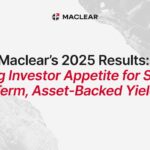Michael Burry often perceives market trends few others can see. If you’re unfamiliar with the name, his darest and most profitable investment was during the 2008 recession when he accurately predicted the housing market would burst. The event is portrayed in Martin Scorsese’s 2015 hit movie The Big Short and remains culturally significant in recent market history.
Burry is known by the investing public for his bearish attitude. Following Scion Asset Management, the fund he runs, can provide valuable insights into the famous investor’s market trends. In this article, we will review Michael Burry’s stock portfolio, analyze his largest stock holding, and see what factors could have influenced his strategic approach.
Who is Michael Burry?
Born in San Jose, California, Michael Burry studied economics and pre-med at the University of California, Los Angeles, ultimately earning his MD from the Vanderbilt University School of Medicine. He started his residency in pathology at Stanford University Medical Center but left before finishing it.
However, the hobby he practiced while off duty at night shifts earned him his reputation: financial investing. Before he left to start Scion Capital, he had already demonstrated proficiency in investing by participating in the stock discussion site Silicon Investor as early as 1996, attracting attention from investment companies and individuals like Joel Greenblatt. In other words, Michael Burry’s portfolio was built even as he was a practicing physician.
Burry has espoused traditional value investing, as put forward by Benjamin Graham and David Dodd in 1934’s investment book Security Analysis. He has been quoted as saying: “All my stock picking is 100% based on the concept of a margin of safety.”
In 2000, Michael Burry ceased participating in web discussions and started Scion Capital hedge fund using inheritance money and family loans. According to Michael Lewis, the author of The Big Short: Inside the Doomsday Machine:
- In 2001, the S&P 500 dropped by -11.88% while Scion jumped 55%;
- In 2002, the S&P dropped once again, by -22.1%, while Burry’s hedge fund marked a jump of 16%;
- In 2003, the market started to recover and rose 28.69%, but Scion made almost double that, returning 50%;
- By the end of 2004, Michael Burry’s portfolio was worth $600 million, and he declined further investments.
Notably, a significant part of these returns came from shorting overvalued technology stocks.
‘The big short’
In 2005, after analyzing mortgage lending practices and balance sheets, Michael Burry shifted from IT to the subprime market. He spotted irregularities, and his research of residential real estate and bonds based on these mortgages led him to believe that they would begin losing value quickly once the interest rates were corrected, likely crashing within a couple of years.
Burry saw the risks of valuing millions of borrowings with low to no income, assets, or down payments for mortgages as solid and realized this was not sustainable in the long run. He then persuaded Goldman Sachs and other investment companies to sell him credit default swaps (CDSs) against what he saw as vulnerable subprime deals.
The companies accepted but charged high premium rates. Furthermore, housing prices kept climbing. Together, these factors caused Burry’s clients to protest his continued short plays and eventually demand their money withdrawn. Burry put a moratorium on withdrawals, causing outrage among his clients, but his analysis proved correct in 2007 when the market crashed.
The daring bet earned Michael Burry a personal profit of $100 million and a profit of over $700 million to his clients. Between its founding in November 2000 and its closing in June 2008, Scion Capital recorded returns of 489.34%. In contrast, the S&P 500 index returned less than 3% (including dividends) over the same period.
Michael Burry’s predictions and hedge fund performance
His famous ‘big short’ play aside, Michael Burry has given his predictions on the market movement and offered various commentary over the years on his cryptic and a bit hectic Twitter account. Furthermore, Michael Burry’s stock portfolio was reshaped according to his successful perception of the market.
However, some of these predictions turned out to be wrong:
- In September 2019, Burry warned that the market would crash: the stock market, as measured by SPY ETF, jumped up 15% in the following 12 months;
- In March 2020, he predicted a significant bearish trend in the market in the wake of COVID-19. However, the S&P 500 gained over 70% in the following 12 months;
- Finally, in January 2023, Burry tweeted: “Sell.” However, the stocks surged, as NASDAQ witnessed the most significant first half of the year in four decades. In March, he stated he was “wrong to say sell.”
Still, as of March 2024, his hedge fund’s stock portfolio gain has been +252.53% since June 2013, according to TipRanks. The average return has been +23.95% in the last 12 months and +30.74% in the past three years (annualized).
Furthermore, the manager-weighted top 20 stocks of Scion Asset Management have consistently outperformed those in the S&P 500 over the last three years, as shown by HedgeFollow:
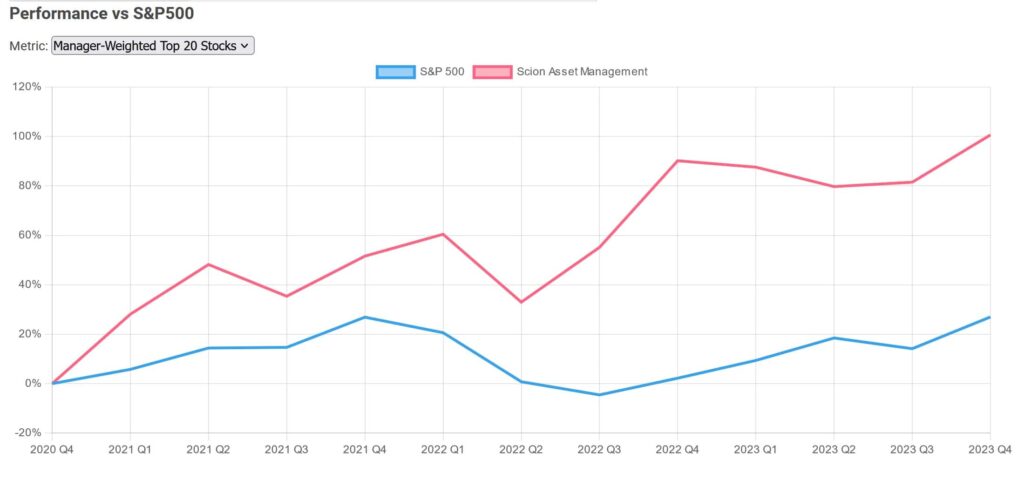
If you followed the steps of the company’s 13F filings over the last three years (February 2021 through February 2024), you would have received annualized total returns of 21.6%. To compare, the S&P 500 ETF (SPY) would have provided you with annualized total returns of 11.0% over the same period.
Michael Burry’s largest stock holding
The latest SEC 13F report of Michael Burry stock portfolio includes 25 different stocks, with no single stock standing out (the largest portfolio component as of Q4 2023 is Alibaba (BABA) at 6.15%). Therefore, instead of focusing only on one stock, we’ll go through the top three holdings, which comprise about 18% of its total public equity. These are:
- Alibaba Group Holdings (NYSE: BABA) – 6.15% of the portfolio;
- JD.com Inc. (NASDAQ: JD) – 6.11% of the portfolio;
- HCA Healthcare Inc. (NYSE: HCA) – 5.72% of the portfolio.
1. Alibaba Group Holdings (NYSE: BABA) – 6.15% of the portfolio
The investor doubled down on Alibaba, boosting his number of shares from 50,000 to 75,000 between Q3 2023 and Q4 2023, which is a large increase of 50% of the stock in Michael Burry’s portfolio.
This stock purchase shows the investor’s confidence amid worries that Chinese companies represent value traps. The stock price has been at its historical low, losing approximately 75% of its value since the 2020 peak, and some investors claim that the stock is significantly undervalued. In any case, Burry feels bullish about Alibaba, expecting a price increase along the lines of his margin of safety philosophy.
Alibaba is a Chinese e-commerce, retail, internet, and technology giant that focuses on operating numerous online marketplaces. It also offers cloud computing services and digital payment solutions through Alipay and is involved in sectors like entertainment, logistics, and artificial intelligence. Alibaba is known as one of the world’s largest and most influential technology companies.
Alibaba stock price today
Alibaba stock price prediction 2025
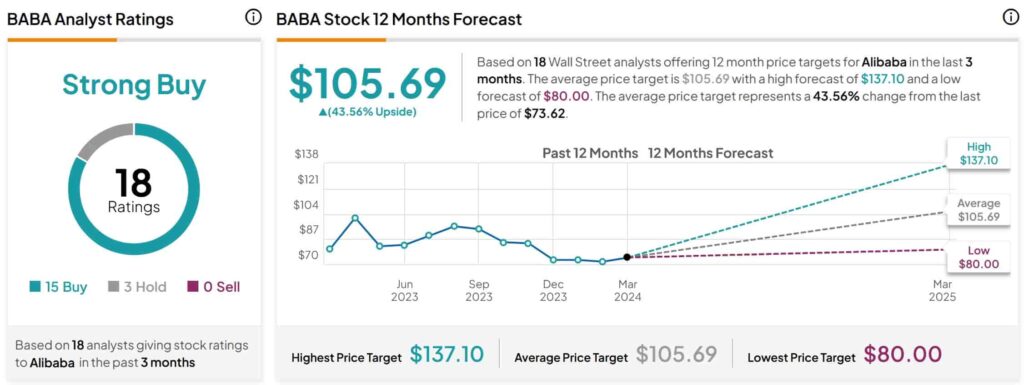
| Metric | Value |
| Alibaba average price target | $105.69 |
| Alibaba high forecast | $137.10 |
| Alibaba low forecast | $80.00 |
| Alibaba change from the last price | 43.60% |
2. JD.com Inc. (NASDAQ: JD) – 6.11% of the portfolio
The reasoning behind Michael Burry’s JD investment is nearly identical to his purchase of Alibaba. However, he increased his position in JD even more, from 125,000 to 200,000 shares, an increase of 60%.
Burry seems to observe that JD stock is highly undervalued. In fact, the JD share price has dropped more than half in the past 12 months and has lost 75% of its value since early 2021. While skeptics argue the company is a value trap, Burry expects to cash in on the sentiment.
JD.com, also known as Jingdong, is a massive Chinese e-commerce company. It operates an online marketplace rivaling Alibaba’s. Furthermore, the company has invested heavily in advanced tech, robots, and artificial intelligence delivery. As a tech company, it is one of the largest in the world in terms of revenue, and represents one of the most significant tech positions in Michael Burry’s stock portfolio.
JD.com stock price today
JD.com stock price prediction 2025
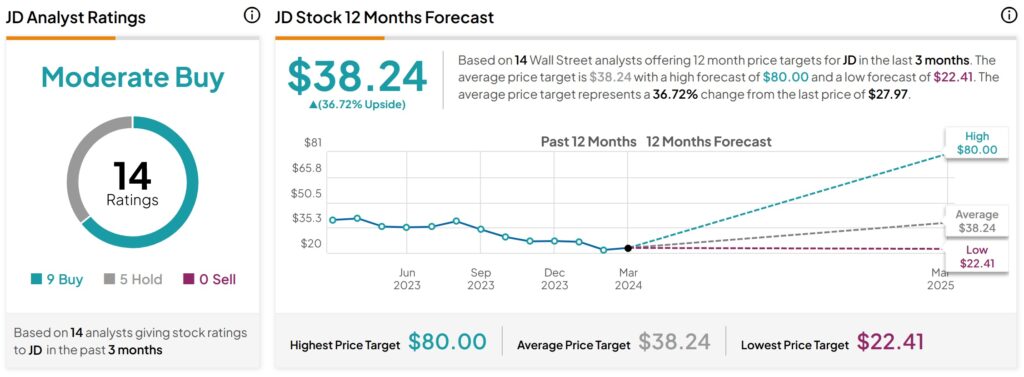
| Metric | Value |
| JD.com average price target | $38.24 |
| JD.com high forecast | $80.00 |
| JD.com low forecast | $22.41 |
| JD.com change from last price | 36.86% |
3. HCA Healthcare Inc. (NYSE: HCA) – 5.72% of the portfolio
Michael Burry’s HCA Healthcare position comes as a surprise to many as this is its first appearance in his portfolio. Scion Asset Management’s filings indicate that the investor purchased 20,000 shares in Q4 2023, instantly making it its third-largest stock position.
The move likely results from a $100 million loss in HCA’s joint venture with Valseco, which caused a historic plunge in the stock’s price immediately after the company released the information in its Q3 2023 report. However, other than that, HCA Healthcare shows real promise due to continuous expansion and a reputation for exceeding analyst expectations in recent years.
HCA Healthcare is one of the largest American healthcare providers, with a substantial network of 186 hospitals and about 2,000 surgery centers, emergency rooms, and clinics across the United States. The company offers various medical services, such as cardiology, oncology, and orthopedics, and has the potential to make a valuable stock on Michael Burry’s portfolio.
HCA Healthcare stock price today
HCA Healthcare stock price prediction 2025
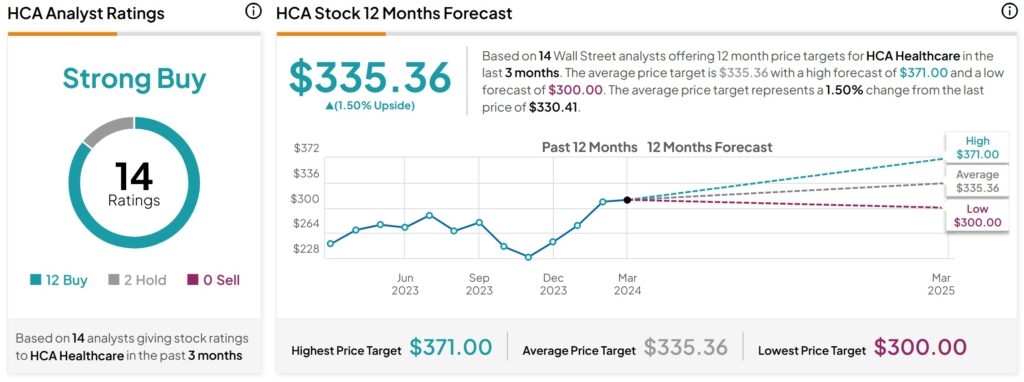
| Metric | Value |
| HCA Healthcare average price target | $335.36 |
| HCA Healthcare high forecast | $371.00 |
| HCA Healthcare low forecast | $300.00 |
| HCA Healthcare change from the last price | 1.59% |
Michael Burry stock portfolio
Since Michael Burry stock portfolio is relatively equally divided among several players, it might be worthwhile to note the ten largest components in Scion Asset Management’s portfolio, including the seven we haven’t mentioned before:
- Alibaba Group Holdings (NYSE: BABA) – 6.15% of the portfolio;
- JD.com Inc. (NASDAQ: JD) – 6.11% of the portfolio;
- HCA Healthcare Inc. (NYSE: HCA) – 5.72% of the portfolio;
- Oracle Corp. (ORCL) – 5.57% of the portfolio;
- Citigroup Inc. (C) – 5.44% of the portfolio;
- CVS Health Corp. (CVS) – 5.43% of the portfolio;
- Nexstar Media Group (NXST) – 5.39% of the portfolio;
- Alphabet Inc. (GOOGL) – 5.17% of the portfolio;
- Star Bulk Carriers Corp. (SBLK) – 4.95% of the portfolio;
- Amazon Inc. (AMZN) – 4.82% of the portfolio.
What’s interesting is that Citigroup, CVS Health, Alphabet (Google), and Amazon are all new additions to Michael Burry’s stock portfolio in the most recent report filings. Furthermore, there has been a notable decline in Nexstar Media Group (-33%) and Star Bulk Carriers (-11.92%). Additionally, positions in Hudson Pacific Properties (HPP), Stellantis NV (STLA), Euronav NV (EURN), and Crescent Energy Company (CRGY) have been sold entirely.
Michael Burry’s current investment portfolio – the bottom line
Michael Burry’s portfolio follows the trail his value investing philosophy has set up. His two largest stock holdings are now Alibaba and JD.com, two beat-down Chinese stocks that are undervalued amidst value trap fears.
In light of these events, the move can be considered risky, but if the ‘big short’ investor proves to be right and the steep decline reverses, he could pocket significant returns.
On the other hand, another observable trend is the ongoing diversification effort, as the new stock positions reflect footholds in healthcare, finances, and technology.
These two trends will dictate the outcome of Burry’s most recent investments: the potential re-emergence of the Chinese e-commerce giants’ stocks and the performance of the new positions in healthcare and, to an extent, finance and technology. If you decide to follow in the footsteps of Michael Burry, bear in mind that no investment outcome is guaranteed, and you should invest only what you can afford to lose.
Disclaimer: The content on this site should not be considered investment advice. Investing is speculative. When investing, your capital is at risk.



